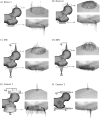QCT/FEA predictions of femoral stiffness are strongly affected by boundary condition modeling
- PMID: 25804260
- PMCID: PMC4583333
- DOI: 10.1080/10255842.2015.1006209
QCT/FEA predictions of femoral stiffness are strongly affected by boundary condition modeling
Abstract
Quantitative computed tomography-based finite element models of proximal femora must be validated with cadaveric experiments before using them to assess fracture risk in osteoporotic patients. During validation, it is essential to carefully assess whether the boundary condition (BC) modeling matches the experimental conditions. This study evaluated proximal femur stiffness results predicted by six different BC methods on a sample of 30 cadaveric femora and compared the predictions with experimental data. The average stiffness varied by 280% among the six BCs. Compared with experimental data, the predictions ranged from overestimating the average stiffness by 65% to underestimating it by 41%. In addition, we found that the BC that distributed the load to the contact surfaces similar to the expected contact mechanics predictions had the best agreement with experimental stiffness. We concluded that BC modeling introduced large variations in proximal femora stiffness predictions.
Keywords: hip fracture; osteoporosis; quantitative computed tomography.
Conflict of interest statement
Figures







References
-
- ANSYS. Mechanical APDL Contact Technology Guide. Chapter 9. SAS IP, Inc.; 2011. ANSYS 14.0 Help Module.
-
- Budynas RG. Advanced Strength and Applied Stress Analysis. McGraw-Hill Education; 1999.
-
- Cody DD, Gross GJ, et al. Femoral strength is better predicted by finite element models than QCT and DXA. Journal of Biomechanics. 1999;32(10):1013–1020. - PubMed
-
- Dall'Ara E, Luisier B, et al. A nonlinear QCT-based finite element model validation study for the human femur tested in two configurations in vitro. Bone. 2013;52(1):27–38. - PubMed
Publication types
MeSH terms
Grants and funding
LinkOut - more resources
Full Text Sources
Other Literature Sources
Medical
